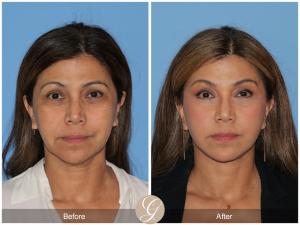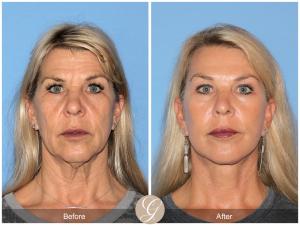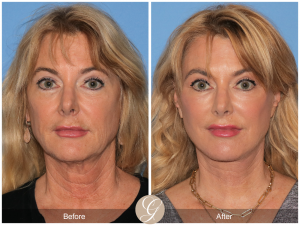
Dr. Kevin Sadati presented his Preservation Deep Plane Facelift Technique at the IMCAS in Paris
Renowned facial plastic surgeons Dr. Kevin Sadati presented his Preservation Deep Plane Facelift Technique at the largest international aesthetic meeting
NEWPORT BEACH, CA, UNITED STATES, February 10, 2025 /EINPresswire.com/ -- In pursue of advancing facial rejuvenation techniques, renowned facial plastic surgeons Dr. Kevin Sadati presented his pivotal study on the Preservation Deep Plane Facelift which has been submitted for publication in the Plastic & Reconstructive Surgery Journal at the IMCAS in Paris. IMCAS is the largest aesthetic and plastic surgery meeting in the world with over 18,000 attendees from all over the globe. Experts from various fields of anesthetic & plastic surgery present their studies and techniques in this meeting. Dr. Sadati’s innovative technique was being hailed as the next generation of facial rejuvenation, setting a new standard for safety, efficacy, and natural outcomes in deep plane facelifting.
First, we need to understand the tissue that causing issue with the aging process. This tissue is called SMAS (Superficial Musculoaponeurotic System). This fibrous tissue lays beneath the skin and above the facial muscles. There are two different characters in SMAS layers, the non-mobile portion which is located around the ears and is firmly adhered to the deep fascia, therefore not affected by the aging process. If you grab this tissue near your earlobes on the face and neck, it barely moves. Therefore, pulling on it will not effectively rejuvenate the face and may actually cause undesirable results after surgery. Traditional facelift relied on pulling of the non-mobile SMAS and the skin which may results in a pulled look, excessive scar formation and short-lasting results.
On the other hand, the mobile SMAS which is affected by aging process is located in the central portion of the face & neck area containing tissues like cheeks, laugh lines, jowls, and the neck bands. The mobile SMAS is not adhered to the underlying tissue therefore, it can glide up and down by pulling on it. At the edges of the mobile SMAS bordering the non-mobile SMAS there are treads like tissues called retaining ligaments of the face and neck that anchor the mobile SMAS to deeper layers. In order to lift the aging tissues in the face and neck, these retaining ligaments must be released. In deep plane facelift technique, these retaining ligaments are released followed by elevation of the mobile SMAS over its gliding fascia and repositioned to a higher location in a vertical direction. Therefore, the deep plane technique addresses the root causes of aging face, resulting in a more natural, longer lasting, and harmonious rejuvenation.
The Preservation Deep Plane Facelift builds upon deep plane techniques but introduces critical refinements that reduce recovery time and optimize results. This advanced method targets the deeper structural layers of the face, including the mobile SMAS, rather than relying on tension placed on the skin.
A defining feature of this approach is the reduction in skin delamination (elevation), preserving the skin’s vascular integrity and minimizing trauma. This minimizes the risk of complications such as hematomas, skin necrosis, and prolonged swelling, while ensuring faster healing and shorter drains requirement. Moreover, the procedure can be performed under twilight sedation rather than general anesthesia, offering patients enhanced safety, reduced systemic risks, and a more comfortable recovery experience.
To create a well-defined jawline for individuals with weak jawline and lack of definition at the angle of mandible, Dr. Sadati has created a unique rotating flap using patient’s own tissue instead of jaw implants or any other artificial fillers. A well-defined or snatched jawline demonstrates sings of youth. In men, this technique is particularly useful to create a very masculine jawline.
To tighten the neck tissue without excessive skin elevation, Dr. Sadati uses special purse-string suturing technique that works like a hammock, anchoring the lax neck muscle called platysma to the back of the ear. Initially, the platysma muscle below the earlobes is elevated, then this cabling sutures lifts the entire neck vertically. This deep neck maneuver minimizes skin delamination, therefore, reduces the chances of hematoma, seroma, skin necrosis, or scar formation along the incision lines.
“This technique represents a paradigm shift in facial rejuvenation. It combines advanced surgical precision with a nuanced understanding of anatomy to achieve results that are not only aesthetically superior but also functionally sound. The quicker recovery time and preserving tissue make it a preferred option for both surgeons and patients.” Dr. Sadati states.
The clinical research study performed by Dr. Sadati and Dr. Alexandre Lellouch, plastic surgeon in private practice in Paris and affiliated with Harvard University compared outcomes from the Preservation Deep Plane Facelift with extended deep plane methods. The findings revealed shorter drainage durations, fewer complications, and more rapid recovery times in patients undergoing the Preservation Facelift. These results underscore the technique’s efficacy and its role as an emerging gold standard in facelifting procedures.
The key innovation of the Preservation Deep Plane Facelift lies in its tissue-sparing approach. By limiting skin dissection and focusing on vertical lifting of deeper structures, such as the SMAS and platysma, this technique delivers long-lasting results while minimizing the telltale signs of surgical intervention. This approach also addresses neck contouring with conserving tissue yet effective maneuvers, such as the platysma purse-string hammock technique, which avoids excessive deep neck tissue resection.
“Patients today demand outcomes that look natural and feel authentic,” Dr. Sadati notes. “This technique meets those expectations while aligning with modern principles of facelift surgery and patient safety.”
Dr. Lellouch emphasizes the transformative potential of this method: “The Preservation Deep Plane Facelift reflects a forward-thinking approach to facial rejuvenation, one that leverages anatomical precision to achieve superior outcomes with fewer risks. It is rapidly becoming the new benchmark for facelifting.”
As aesthetic medicine continues to evolve, the Preservation Deep Plane Facelift stands out as a landmark innovation, offering patients a safer, more effective path to natural rejuvenation. Dr. Sadati and Dr. Lellouch’s contributions highlight the critical importance of advancing surgical techniques to meet the changing needs and expectations of patients.
Kevin s Sadati
Gallery of Cosmetic Surgery
+1 949-485-8101
email us here
Visit us on social media:
Facebook
LinkedIn
Instagram
YouTube
TikTok
Lean about Deep Plane Facelift
Distribution channels: Beauty & Hair Care, Consumer Goods, Healthcare & Pharmaceuticals Industry, Media, Advertising & PR, Movie Industry
Legal Disclaimer:
EIN Presswire provides this news content "as is" without warranty of any kind. We do not accept any responsibility or liability for the accuracy, content, images, videos, licenses, completeness, legality, or reliability of the information contained in this article. If you have any complaints or copyright issues related to this article, kindly contact the author above.
Submit your press release


